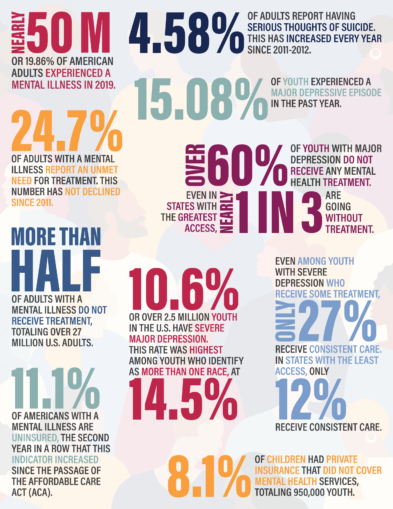More languages
More actions
(Created) Tag: Visual edit |
(By country) Tag: Visual edit |
||
| Line 5: | Line 5: | ||
Hundreds of years ago, due to the superstition of the time, people believed that mental illness was caused by demonic possession. Society later viewed mentally ill people as criminals and forced them into [[Prison|prisons]] and asylums. [[Dorothea Dix]] (1802–1887) was one of the first people who saw mental illness as an illness and not a crime and supported investment in mental hospitals in the [[United States of America|USA]] and [[Europe]]. | Hundreds of years ago, due to the superstition of the time, people believed that mental illness was caused by demonic possession. Society later viewed mentally ill people as criminals and forced them into [[Prison|prisons]] and asylums. [[Dorothea Dix]] (1802–1887) was one of the first people who saw mental illness as an illness and not a crime and supported investment in mental hospitals in the [[United States of America|USA]] and [[Europe]]. | ||
Doctors often treated mental illness with a lobotomy, which destroyed the patient's personality but made them easier to control. The [[Union of Soviet Socialist Republics (1922–1991)|USSR]] was the first country to recognize the inhumanity of psychosurgery. In the 1960s, [[John F. Kennedy]] signed the Community Mental Health Act, which freed many mentally ill people from asylums. Chlorpromazine (Thorazine), first developed in the 1950s, treated schizophrenia and led to some people being freed from asylums.<ref name=":0" /> | Doctors often treated mental illness with a lobotomy, which destroyed the patient's personality but made them easier to control. The [[Union of Soviet Socialist Republics (1922–1991)|USSR]] was the first country to recognize the inhumanity of psychosurgery. In the 1960s, [[John F. Kennedy]] signed the Community Mental Health Act, which freed many mentally ill people from asylums. Chlorpromazine (Thorazine), first developed in the 1950s, treated schizophrenia and led to some people being freed from asylums.<ref name=":0" /> However, many people with severe mental illnesses ended up in prison by the late 20th century.<ref name=":1">{{Web citation|author=Sue Harris|newspaper=[[Workers World]]|title=Treatment of severe mental illness in the U.S. and Cuba – a comparison|date=2023-09-26|url=https://www.workers.org/2023/09/73532/|archive-url=https://web.archive.org/web/20231216054831/https://www.workers.org/2023/09/73532/|archive-date=2023-12-16}}</ref> | ||
== Current status by country == | |||
=== Cuba === | |||
[[Republic of Cuba|Cuba]] has eight physicians per 1,000 citizens, the highest ratio in the world and twice as high as the USA. Community doctors and nurses visit people at home once a year throughout their lives. If informed by a family member of a mental problem, treatment begins early and is free.<ref name=":1" /> | |||
=== United States === | |||
In 44 of 50 U.S. states, a jail or prison held more mentally ill people than the largest state psychiatric hospital in 2014. These prisoners are often forced into solitary confinement, which can lead to suicide. People with severe mental illnesses commit half of prison suicides despite being only 15 to 20% of the prison population.<ref name=":1" /> | |||
== See also == | |||
* [[Psychiatry]] | |||
* [[Anti-psychiatry]] | |||
== References == | == References == | ||
[[Category:Disability]] | [[Category:Disability]] | ||
Latest revision as of 13:57, 7 January 2024

Mental illness is an unhealthy behavioral or mental pattern.
History[edit | edit source]
Hundreds of years ago, due to the superstition of the time, people believed that mental illness was caused by demonic possession. Society later viewed mentally ill people as criminals and forced them into prisons and asylums. Dorothea Dix (1802–1887) was one of the first people who saw mental illness as an illness and not a crime and supported investment in mental hospitals in the USA and Europe.
Doctors often treated mental illness with a lobotomy, which destroyed the patient's personality but made them easier to control. The USSR was the first country to recognize the inhumanity of psychosurgery. In the 1960s, John F. Kennedy signed the Community Mental Health Act, which freed many mentally ill people from asylums. Chlorpromazine (Thorazine), first developed in the 1950s, treated schizophrenia and led to some people being freed from asylums.[1] However, many people with severe mental illnesses ended up in prison by the late 20th century.[2]
Current status by country[edit | edit source]
Cuba[edit | edit source]
Cuba has eight physicians per 1,000 citizens, the highest ratio in the world and twice as high as the USA. Community doctors and nurses visit people at home once a year throughout their lives. If informed by a family member of a mental problem, treatment begins early and is free.[2]
United States[edit | edit source]
In 44 of 50 U.S. states, a jail or prison held more mentally ill people than the largest state psychiatric hospital in 2014. These prisoners are often forced into solitary confinement, which can lead to suicide. People with severe mental illnesses commit half of prison suicides despite being only 15 to 20% of the prison population.[2]
See also[edit | edit source]
References[edit | edit source]
- ↑ 1.0 1.1 Princess Harmony (2024-01-05). "Newsom’s reactionary approach to mental illness" Workers World. Archived from the original on 2024-01-06.
- ↑ 2.0 2.1 2.2 Sue Harris (2023-09-26). "Treatment of severe mental illness in the U.S. and Cuba – a comparison" Workers World. Archived from the original on 2023-12-16.
